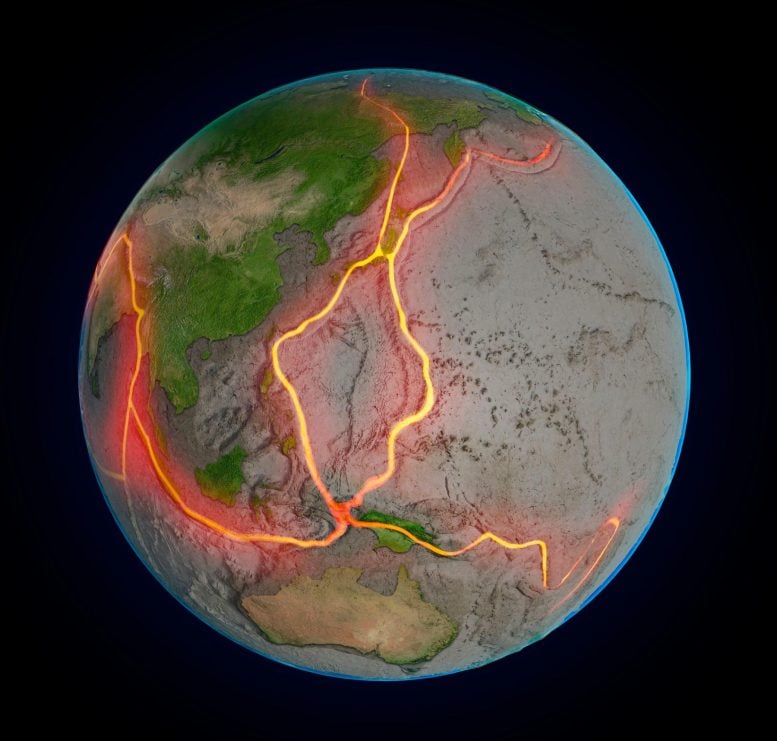
A recent study challenges traditional views on how Earth’s continents were formed, suggesting that subduction may not have been necessary. His findings propose that the melting of Earth’s crust could explain the formation of continents, casting doubt on when plate tectonics began and highlighting its impact on life’s origin.
The formation of Earth’s continents billions of years ago created a foundation for life to flourish. However, scientists remain divided on how these landmasses came into existence and whether the geological processes involved are the same as those we observe today.
A recent paper from the University of Illinois Chicago’s David Hernández Uribe in Nature Geoscience adds new information to that debate, poking holes in the leading theory of continent formation. Hernández Uribe used computer models to study the formation of magmas thought to hold clues to the origin of continents.
Geological Processes and Zircon Studies
Magma is the molten substance that, when it cools, forms rocks and minerals. Hernández Uribe looked for magmas that match the compositional signature of rare mineral deposits called zircons that date back to the Archaean period of 2.5 to 4 billion years ago, when scientists believed that continents first formed.
Last year, scientists from China and Australia published a paper arguing that Archaean zircons could only be formed by subduction — when two tectonic plates collide underwater, pushing land mass to the surface. That process still happens today, causing earthquakes and volcanic eruptions and reshaping the coasts of continents.
But Hernández Uribe, assistant professor of earth and environmental sciences, found that subduction was not necessary to create Archaean zircons. Instead, he found that the minerals could form through high pressure and temperatures associated with the melting of the Earth’s thick primordial crust.
“Using my calculations and models, you can get the same signatures for zircons and even provide a better match through the partial melting of the bottom of the crust,” Hernández Uribe said. “So based on these results, we still do not have enough evidence to say which process formed the continents.”
Implications on Plate Tectonics and Life on Earth
The results also raise uncertainty about when plate tectonics started on Earth. If Earth’s first continents formed by subduction, that meant that continents started moving between 3.6 to 4 billion years ago — as little as 500 million years into the planet’s existence. But the alternative theory of melting crust forming the first continents means that subduction and tectonics could have started much later.
“Our planet is the only planet in the solar system that has active plate tectonics as we know it,” Hernández Uribe said. “And this relates to the origin of life, because how the first continents moved controlled the weather, it controlled the chemistry of the oceans, and all that is related to life.”
Reference: “Generation of Archaean oxidizing and wet magmas from mafic crustal overthickening” by David Hernández-Uribe, , 11 July 2024, Nature Geoscience.
DOI: 10.1038/s41561-024-01489-z
4 Comments
“Hernández Uribe looked for magmas that match the compositional signature of rare mineral deposits called zircons …”
Magmas are molten mixtures of potential minerals, found under the surface; if they break out and flow on the surface, they are called lava. If a magma or lava cools and crystalizes into a rock, it is then called by a rock name, determined by the species, size, and abundance of the various minerals, such as “granite” or “gabbro.”
Zircons do not form “deposits” like gold or copper. The are a ubiquitous, minor accessory silicate mineral of many rocks. While not actually abundant enough to form mono-mineralic rocks that might hypothetically be called “zirconites,” they are sufficiently common to be able to be liberated from their host rocks by crushing, and separated using their property of high density.
Zircons are not the main proxy for continental crust growth, their inclusions elements are. And this year a new massive data set combined with machine learning to use a larger set of elements led to a model that – somewhat surprisingly to me – suggests plate tectonics starting ~ 4.2 billion years ago, just around the time life evolved. Life is now dated to 4-3-4.2 billion years from two new cross bracing tree methods, adding to the 4.2 years consensus of TimeTree reference papers since early 00’s, and the last paper identifies how the a bit later LUCA was living in an ecology with viruses and ability to live at the ocean or land surface.
“The source of Earth’s oldest materials has been debated using traditional approaches to trace elements and isotopes of zircon. Using a single geochemical proxy, like P contents or oxygen isotopes, for source fingerprinting can be ambiguous. Here, we employ machine learning in multidimensional space, incorporating an array of zircon trace elements. This approach is beneficial for low-P zircon, prevalent in the Hadean. We find significant proportions of S-type granite in the Hadean Jack Hills zircon as far back as 4.24 Ga. These proportions exhibit regular variations in supercontinent-like cycles, mirroring patterns observed in global detrital zircon throughout Earth’s history. This suggests that exposed continents, weathering, and subduction-driven plate tectonics were active since the Hadean, facilitating the habitability of early Earth.”
“Sediment subduction in Hadean revealed by machine learning”,
Jilian Jiang https://orcid.org/0000-0002-1170-8982, Xinyu Zou, Ross N. Mitchell. PNAS, 2024.
“their inclusions elements” – their inclusion’s elements.
“Zircons are not the main proxy for continental crust growth, their inclusion’s elements are.”
While the article whose link you provided does mention muscovite inclusions, it also specifically says that the trace element isotopes in the zircon itself are the critical discriminators.